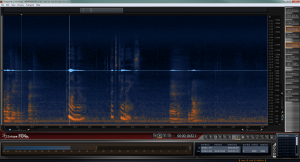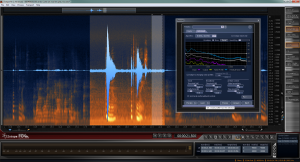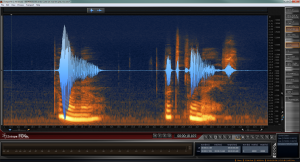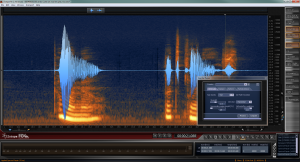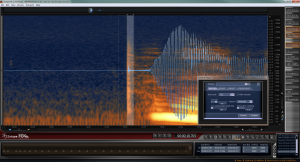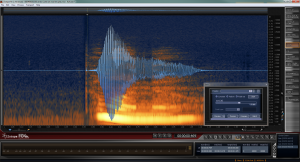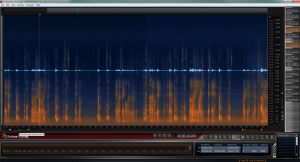 When I open an audio file and it looks like this…
When I open an audio file and it looks like this…
…I start gathering microphones together cause we’re gonna do some ADR! The light blue line is the waveform and it’s barely registering.
Click on the image and see it’s only hitting about -40 dB. Broadcast quality dialog needs to live in the -12 realm.
Now, give it a listen… [soundcloud url=”http://api.soundcloud.com/tracks/80241746″ params=”” width=” 100%” height=”80″ iframe=”true” /]
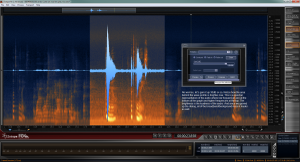 No worries, I gained up a section of the file about 30Db. Notice how the area behind the wave profile is brighter now. This is a spectral representation of the audio where low frequencies are at the bottom of the graph and higher frequencies at the top. The brightness is the loudness of the audio. And since we gained up the dialog, all of the broadband/background noise is louder.
No worries, I gained up a section of the file about 30Db. Notice how the area behind the wave profile is brighter now. This is a spectral representation of the audio where low frequencies are at the bottom of the graph and higher frequencies at the top. The brightness is the loudness of the audio. And since we gained up the dialog, all of the broadband/background noise is louder.
[soundcloud url=”http://api.soundcloud.com/tracks/80241742″ params=”” width=” 100%” height=”80″ iframe=”true” /]
To get rid of the broadband noise, but keep the louder dialog; we highlight a portion of “silence” between spoken dialog. Once selected we then “teach” the software to understand that spectral noise pattern.
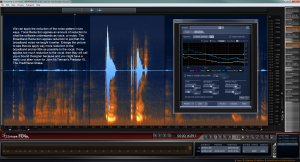 We can apply the reduction of the noise pattern in two ways. Tonal Reduction applies an amount of reduction to what the software understands as voice, or music. The Broadband Reduction applies reduction to just that: the broadband noise we taught it earlier. Enlarge the picture to see that we apply way more reduction to the broadband and as little as possible to the vocal. If one applies too much reduction to the vocal, then they will call you a Sound Designer because and you might have a really cool alien voice for John McTiernan’s Predator IX, The Pred Shake.
We can apply the reduction of the noise pattern in two ways. Tonal Reduction applies an amount of reduction to what the software understands as voice, or music. The Broadband Reduction applies reduction to just that: the broadband noise we taught it earlier. Enlarge the picture to see that we apply way more reduction to the broadband and as little as possible to the vocal. If one applies too much reduction to the vocal, then they will call you a Sound Designer because and you might have a really cool alien voice for John McTiernan’s Predator IX, The Pred Shake.
[soundcloud url=”http://api.soundcloud.com/tracks/80241745″ params=”” width=” 100%” height=”80″ iframe=”true” /]
Ok here’s what you need to know about me, Brian, and all of the post peeps at Art House… When we’re doing Dialog Editing, we’re thinking Academy Award. I know we’ll never experience anything close to that but that is honestly how we roll. So with that in mind… what’s up with those lip smacks?
You can see them here in between the “Come on now…let’s play nice.” The actress was costumed in a tight black dress, tall boots, and had a pile of red lipstick on her lips.
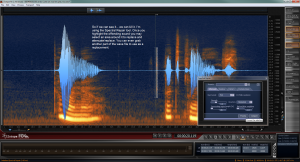 So if we can see it… we can kill it. I’m using the Spectral Repair tool. Once you highlight the offending sound you may select an area around it to replace and attenuate/replace. You can even grab another part of the wave file to use as a replacement.
So if we can see it… we can kill it. I’m using the Spectral Repair tool. Once you highlight the offending sound you may select an area around it to replace and attenuate/replace. You can even grab another part of the wave file to use as a replacement.
Lip Smacks be gone.
[soundcloud url=”http://api.soundcloud.com/tracks/80241744″ params=”” width=” 100%” height=”80″ iframe=”true” /]
While we’re at it, lets see what we can about the “Kehhh” at the beginning of the “Come on” line. Sometimes we’ll leave these kinds of things alone, but this is a very quiet and personal moment in the scene and the click-like sound the mic is picking up is annoying. I don’t want to get rid of it completely but I need to tame it a bit.
[soundcloud url=”http://api.soundcloud.com/tracks/80241741″ params=”” width=” 100%” height=”80″ iframe=”true” /]
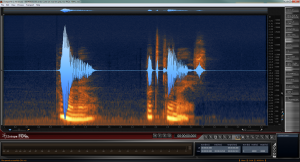 Now this is ready to re-sync with the dialog edit session, then we’ll do some EQing and ducking – more on that later.
Now this is ready to re-sync with the dialog edit session, then we’ll do some EQing and ducking – more on that later.
[soundcloud url=”http://api.soundcloud.com/tracks/80265448″ params=”” width=” 100%” height=”80″ iframe=”true” /]

